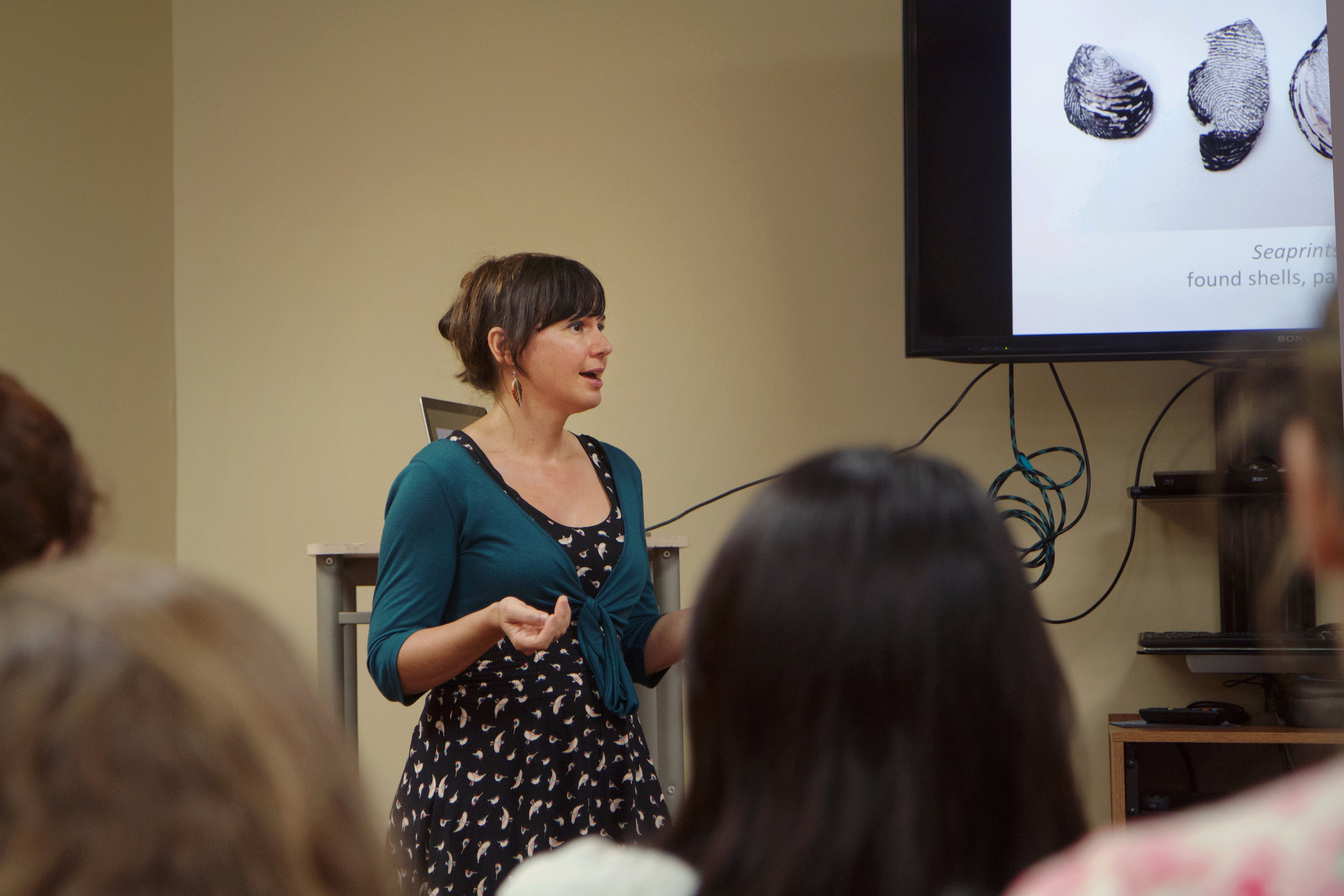Artist Jenine Shereos addresses Covenant art students and others at "Inmaterial." Photo by Caleb Smith.
On Thursday, Sept. 21, Jenine Shereos led a discussion about her art collection titled “Immaterial: Cloth in Collaboration,” which is currently on display in the Kresge second-floor gallery. She fielded questions about her art with humility and openness in her pleasant, soft-spoken manner. Jenine’s art reflects her graceful, unimposing personality, and leaves the thoughtful viewer with questions about man’s place in nature and art’s ability to bring the two closer together.
Jenine earned her undergraduate degree in 2D art, but it was only when she began graduate studies at California State University, Long Beach that she discovered the wonderful potential for fibers in art. The term “fibers” encompasses all sorts of ways to create: dyeing fabric, paper making, weaving, and printing on fabric, among others. Though her career has varied, Jenine has found herself returning to this division of the art world. Since graduating, Jenine has held residencies in Boston, Maine, France, America’s West Coast, and most recently, the Appalachian Mountains. The unique ecosystems of each of these places has left its mark on Jenine’s work by providing her with a new set of materials to work with and imitate.
Three distinct examples of Jenine’s art are displayed in the Kresge art gallery. First, there is a series of knitted pieces titled De/Constructed Lace, each of which imitates a certain type of plant-life. Red, green, and aqua, these swaths of material were knit by Jenine using a knitting machine with pre-set patterns. The patterns are intentionally manipulated to evoke the patterns of nature. These pieces are pinned to the wall like delicate insect specimens on display, and are closely tied to the second type of art in the gallery: photographs of Jenine’s knitted pieces inserted into nature.
For example, De/Constructed Lace (Seaweed) has been hung next to a photograph titled “Knit Seaweed,” which depicts the lace immersed in New England water, looking very much like a clump of natural seaweed. Observing both the photograph and the lace together allows the viewer to admire the depth of Jenine’s work. Each element is beautiful on its own, but together they create an even more beautiful homage to nature’s ephemeral beauty.
Jenine’s third type of art in the gallery is a series of eight cyanotypes which bear images of her knitted pieces. Cyanotypes are blue and white ‘photographs’ made on photosensitized paper, where spaces exposed to light turn blue, and any covered areas remain white. The results are striking outlines of whatever has been put on the paper. Jenine’s knitted pieces leave marks that bring to mind spiders webs and coral reefs and waves washing up on the sand.
The combination of these three types of artwork is powerful because it causes the viewer to consider just what Jenine’s art is. Out of one artistic process, three different pieces are produced. So, what and where is her art? Is it the knitted lace, so thoughtfully crafted, or the period of performance when her pieces were placed in their natural settings? Or perhaps the photographs that capture moments of that performance are the real art?
Jenine herself acknowledged this tension in her lecture on her work Thursday evening.
For her, and for the thoughtful viewer, open questions like these in her art invite contemplation long after one has left the gallery.
One of my favorite pieces displayed in “Immaterial” is Winter Leaves, a photograph of what appears to be two skeletal red leaves, barely hanging onto their branch. However, upon getting acquainted with Jenine’s work, one realizes that the intricate veins which are falling so delicately apart are not truly decayed leaves: they are actually embroidered and knotted human hair, so intricately woven that one could look and never realize this was not the result of natural processes.
This piece, so beautiful on the surface, is loaded with complexities. Why hair? In some contexts, hair is luxurious and beautiful to us, and yet there are many places where an unexpected hair is disgusting. Jenine has used the crown of a human head to mimic the crown of a tree, and the result is delightfully contradictory.
This piece exemplifies many of the recurring themes in Jenine’s work. It explores man’s place in nature and provides Jenine the opportunity to place a piece of herself into her natural surroundings. The leaves are a product of both carefully planned, repetitious processes and of nature’s ability to enhance a piece in unexpected ways. Finally, Winter Leaves is an example of the poetic harmony that occurs when a person chooses to work in conjunction with the nature surrounding them, which is the focus of much of Jenine’s work.
Jenine’s work will be on display in the Kresge Library’s upstairs gallery through October 4. You can check out more of her work on her Instagram account, @jenine_shereos, or on her website: www.jenineshereos.com.

